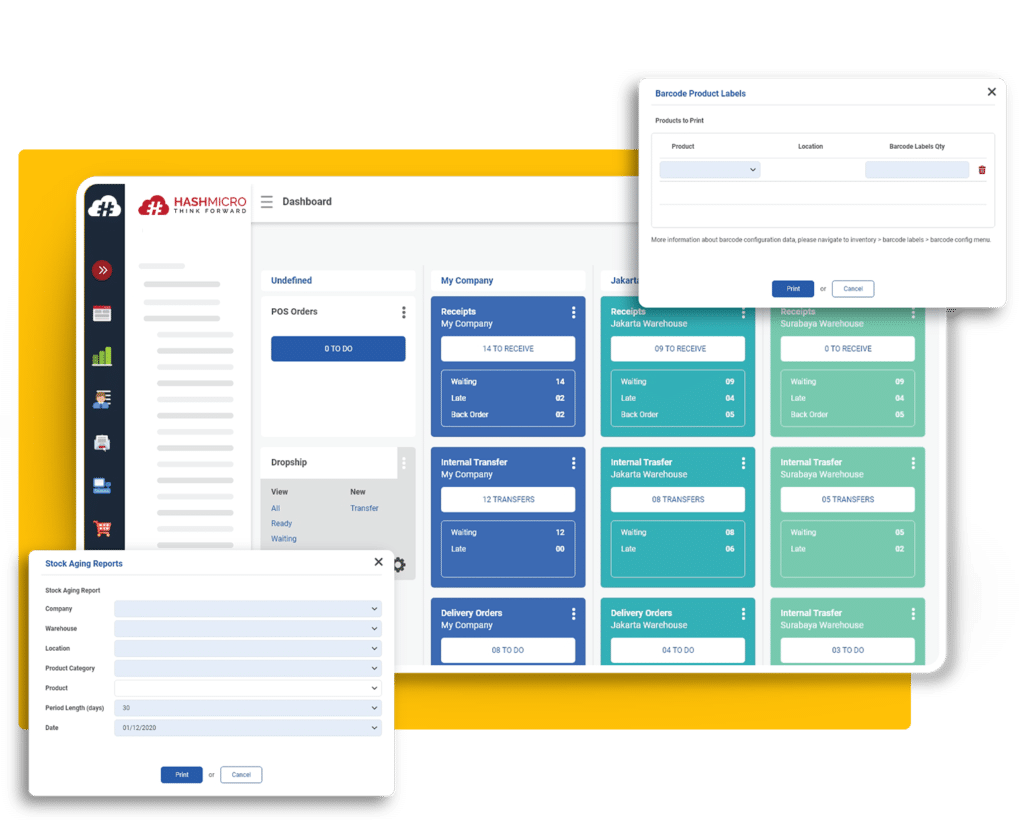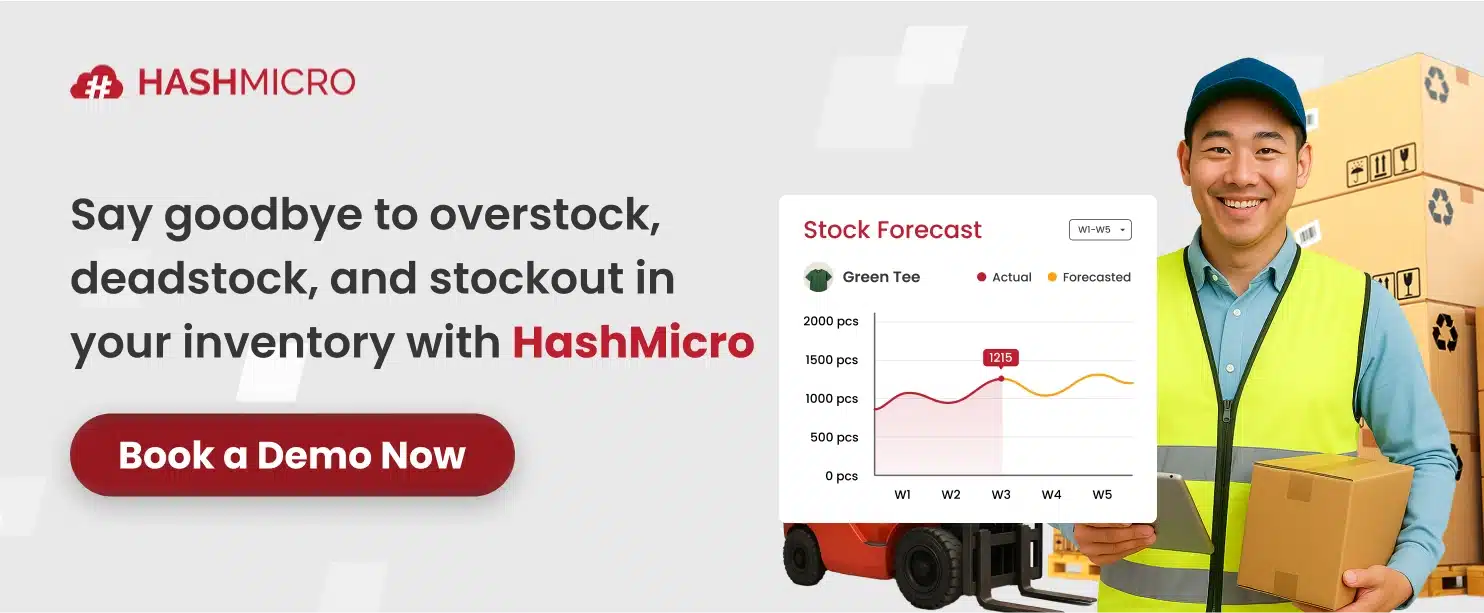As a startup owner, I know how frustrating manual inventory management can be. Human errors, stock miscalculations, and overordering often slow down growth and eat into profits. That’s why adopting inventory management software is essential for scaling efficiently.
In the Asia Pacific region, including Singapore, the demand for smarter inventory systems continues to rise. The market is expected to grow at a CAGR of 11.9% from 2023 to 2030, showing how businesses are rapidly embracing automation and real-time visibility to stay competitive.
Among the top 5 solutions, HashMicro Inventory Management Software stands out with its automated workflows, supplier tracking, and optimized procurement features, which boost efficiency and profitability. Want to see how it can transform your operations? Try the free demo today!
Key Takeaways
|
Shortlisted Inventory Management Software for Startups
From my experience and exploration, I’ve seen how various inventory management software can greatly streamline operations and minimize errors. Below are some of the top inventory management software I recommend.
Best Because
The best end-to-end solution for all types of business needs
Best Because
Best Because
Its flexible software with customizable automation
Best Because
Real-time tracking with automated fulfilment
Best Because
Affordable, customizable, and multi-channel friendly
What is Inventory Management for Your Startups?
Inventory management startups is tracking inventory, organizing, and controlling stock to ensure optimal supply levels. It helps streamline operations by efficiently managing raw materials, finished products, and other inventory-related activities.
With effective inventory management, I can prevent overstocking or stockouts, helping me cut unnecessary costs and maintain healthy cash flow. It also gives me real-time data on stock levels, allowing me to make better decisions, fulfill orders faster, and build a stronger foundation for scaling my operations.
Hashy AI Fact

Need to Know
AI helps you know what you have and what you need before you even need them. HashMicro Inventory Software ensure optimal inventory control with low stock notification and future inventory demand forecast.
Request a free demo today!
Benefits of Startup Inventory Management Software

In the midst of running an exciting startup, I often find it challenging to keep track of all the inventory I need. That’s why I rely on inventory management software—it offers so many benefits, including:
1. Managing startup inventory cost
Businesses often have limited resources and a small number of employees, which means they have to do everything themselves and rely on their own knowledge. As a result, they may underestimate or undervalue the potential costs of starting their business.
Using suitable inventory management software for startups helps you avoid this problem by providing accurate information about your startup inventory costs so that you know what you’re getting into before investing in opening your business.
2. Managing startup inventory risk
There is always some degree of risk involved in starting a new business venture. However, being aware of these risks can help ease any concerns before investing in something new or at least give peace of mind so that things don’t seem so daunting when looking back later on down the line.
The inventory management startups will provide you with a complete analysis of your startup inventory to inform you of those risks. Additionally, integrating a cloud based inventory system ensures real-time tracking and better risk management for your business.
Also read: ERP System Inventory Management for Your Business
Key Features of Inventory Management Software
Inventory management software provides me with a range of features to simplify and optimize my stock management. These tools help me stay organized, avoid costly mistakes, and boost overall efficiency. Let’s take a look at some of the key features and how they benefit my business.
- Real-time inventory tracking: This feature allows startups to monitor stock levels instantly. It provides up-to-date information on product availability, enabling businesses to make timely restocking decisions and prevent stockouts.
- Automated stock updates: Inventory software automatically adjusts stock quantities after each sale or restock. This reduces manual data entry errors, ensures accurate inventory records, and saves time for business owners.
- Low inventory alerts: Startups receive automatic notifications when stock levels fall below a threshold. These alerts help prevent costly fulfilment delays by ensuring that critical products are always available.
- Barcode scanning integration: With barcode scanning, startups can speed up inventory management processes. This feature ensures fast, error-free item tracking and simplifies stock-taking, improving overall efficiency.
- Multi-location management: This feature provides centralized control for startups managing multiple locations or warehouses. It offers visibility into inventory across all sites, ensuring seamless coordination and resource allocation.
- Detailed reporting: The software generates reports on inventory performance, sales trends, and stock movement. Startups can use these insights to make data-driven decisions, optimize operations, and improve profitability.
Also read: Top Inventory Management Software Systems in Singapore
Integrations of Inventory Software
I can integrate my inventory management software with other systems, such as accounting, billing, and purchasing. This makes it easier for me to track every product purchase that goes into my inventory accurately.
Integrating this information will also enable you to identify any issues with the current setup, allowing for adjustments to be made as needed. There are many benefits to integrating inventory management software into other systems in your startup.
It increased efficiency and accuracy within each system and enhanced communication among all parties involved in managing inventory reconciliation within the company, both directly and indirectly.
Additionally, it eliminates potential errors due to duplicated entries because everything stays connected throughout all processes involved in a business.
Top 5 Inventory Management Software for Startups
Choosing the right inventory management software is crucial for me to streamline my startup’s operations. Here are the top 5 inventory management software options that help me manage inventory more effectively as my business grows.
1. HashMicro

HashMicro Inventory Management Software offers comprehensive inventory management software for startups. The system features barcode scanning, multi-location management, and detailed reporting, ensuring efficient and accurate inventory handling.
I chose HashMicro because it integrates seamlessly with other business functions, such as accounting, sales, and procurement. This smooth coordination across departments, combined with AI-driven analytics, helps me make data-backed decisions that drive my startup’s growth.
Depending on my business needs, I can explore a tailored inventory management solution that truly fits my goals. With up to 70% funding support through the CTC Grant, I have the opportunity to experience HashMicro’s system firsthand by requesting a free demo today.
Click the banner below to learn more about how HashMicro can transform my startup’s inventory management. There, I can explore various pricing schemes and select the package that best suits my budget and business objectives.
2. NetSuite
I chose NetSuite because it provides a unified platform that helps me manage stock levels, sales orders, and procurement all in one place. With real-time visibility, I can easily track inventory across multiple locations and streamline order fulfillment.
By integrating its ERP system, I can manage finances, CRM, and inventory seamlessly. Its advanced reporting and demand planning tools help me optimize stock levels, reduce costs, and make smarter business decisions.
3. Monday.com
I chose Monday.com because it gives me the flexibility to customize my inventory management workflows to match my startup’s unique needs. Its visual dashboards and automation make it easy for me to track stock movements with transparency and efficiency.
What I love most is how it integrates seamlessly with other business tools, ensuring smooth data flow. Additionally, its collaborative features enable my team to manage inventory more effectively together, improving both communication and operational performance.
4. ShipBob
I choose ShipBob because it helps me manage inventory, order fulfillment, and shipping all in one platform. With real-time tracking and automated fulfillment processes, I can manage logistics more efficiently and ensure my customers’ satisfaction.
I also appreciate how it integrates smoothly with major e-commerce platforms, giving me a seamless flow of inventory data. Additionally, ShipBob’s analytics offer valuable insights into shipping performance, enabling me to optimize my supply chain and make more informed operational decisions.
5. Zoho Inventory
I chose Zoho Inventory because it enables me to manage inventory, orders, and shipments efficiently from a single platform. With features like multi-channel selling, automated workflows, and real-time stock tracking, it gives me the flexibility I need to run my growing business smoothly.
What I like most is how it integrates seamlessly with other Zoho apps, creating a comprehensive ecosystem to manage various aspects of my business. Its customizable and affordable features make it an ideal solution for my startup’s evolving needs.
How to Source Inventory for Your Startup
Getting my inventory right is crucial for my startup’s success. The way I source and manage inventory directly affects my cash flow, operations, and customer satisfaction. Here’s the step-by-step approach I follow to secure inventory and build a solid supply chain.
1. Define Your Product Requirements
Before you begin sourcing, it’s essential to define what you need clearly:
- Product Type: Are you dealing with raw materials, finished products, or a mix of both? Identifying this upfront will guide your supplier search.
- Quantity Planning: Estimate the amount of inventory you’ll need based on sales projections. Start small and scale as you gain insights into demand.
- Quality Control: Make sure the products align with your quality standards. Whether it’s materials or finished goods, consistency matters.
2. Source Reliable Suppliers
Building relationships with dependable suppliers is key to maintaining a steady inventory flow:
- Research Suppliers: Explore local and international suppliers through platforms like Alibaba, ThomasNet, or local trade directories. Look for suppliers with strong reputations and track records.
- Network at Trade Shows: If possible, attend industry trade shows or online events. These are great places to meet suppliers, get samples, and negotiate better deals.
- Negotiate Terms: Price is important, but don’t overlook lead times, payment terms, and return policies. Negotiating favorable terms will ensure smooth operations.
3. Start Small and Test
Don’t overcommit from the start:
- Small Test Orders: Place smaller orders initially to test the market, assess supplier reliability, and understand demand. This also gives you an opportunity to fine-tune your inventory management.
- Build Relationships: Establish strong partnerships with your suppliers. Good relationships can lead to better terms, priority support, and flexibility in future orders.
4. Look for Local Sources
Local suppliers can offer significant advantages:
- Faster Delivery: Working with local vendors means quicker turnaround times and lower shipping costs.
- Wholesale Markets: Depending on your location, you may find local wholesale markets that offer competitive prices for bulk purchasing.
5. Leverage Technology for Inventory Management
Managing inventory effectively is key to avoiding stockouts and overstocking:
- Inventory Management Software: Invest in tools like HashMicro or other inventory management platforms to keep track of stock, optimize reorder cycles, and ensure you never run out of key products.
- Forecasting Demand: With the right tools, you can analyze sales trends and forecast demand, helping you order just the right amount of inventory.
6. Consider Dropshipping (for E-Commerce Startups)
If you’re running an e-commerce startup, dropshipping can be a low-risk way to start:
- Zero Upfront Costs: Dropshipping allows you to sell products without needing to purchase inventory upfront. The supplier ships products directly to your customers.
- Risk-Free Testing: This model allows you to test different products without the risk of holding excess stock, making it a great option for early-stage businesses.
7. Track and Optimize Your Inventory
Once you have inventory in place, keeping track of it efficiently is essential:
- Monitor Stock Levels: Use your inventory system to monitor real-time stock levels and avoid shortages or overstocking.
- Set Reorder Points: Set automatic reorder points to ensure you never run out of high-demand products, while keeping excess inventory at bay.
“Inventory management startups are redefining how businesses handle stock visibility and fulfillment. With automation, AI forecasting, and real-time analytics, they help companies eliminate waste, improve accuracy, and scale operations faster than ever before.”
— Angela Tan, Regional Manager
Conclusion
Inventory management software for startups is essential to help them succeed. The right software will adapt to the changes you face, ultimately enabling you to make more informed business decisions with real-time data.
By implementing HashMicro’s Inventory Management Software, I can streamline my startup’s inventory processes and gain valuable insights that drive growth and scalability.
I’m choosing to embrace the same technology trusted by leading startups to stay competitive and prepare my business for long-term success. I only need to fill out the form to get my free demo today!

FAQ About Inventory Management Startups
-
How do I start managing inventory?
To start managing inventory, organize and categorize all stock items, set up a tracking system (manual or digital), and establish reorder points. Then, regularly conduct inventory audits to monitor stock levels, ensuring accurate data for decision-making.
-
How to enhance inventory management?
Enhance inventory management by using automation tools to track real-time stock levels, forecast demand, and optimize reorder points. Implement barcode scanning and streamline processes to reduce errors, increase efficiency, and prevent overstocking or stockouts.
-
Can ERP be used for inventory management?
Yes, ERP can be used for inventory management by integrating various business functions into one system. It offers real-time tracking, automates stock updates, and provides valuable insights into inventory trends, enabling better decision-making and improving overall efficiency.



















